Artillery and Armour in the USA: Connecticut (2)
Artillery, Tanks and Armoured Fighting Vehicles in Connecticut (Part 2)
One of the aims of this website is to locate, identify and document every historical piece of artillery and all armoured fighting vehicles preserved in New England. Many contributors have assisted in the hunt for these tangible pieces of our military history and the list you see here is constantly being revised as new finds are discovered and the data is updated. The photos have come from various contributors, but the author likes to "ground truth" the reports, so a good number of the photos are by the author unless otherwise credited. Any errors found here are by the author. It often happens that military monuments that are relatively mobile, have been moved for restoration or scrapped. Sometimes they are repainted with different markings and serial numbers, or they are replaced with a different piece of kit. For those reasons, any additions, deletions, corrections or amendments that you may be able to add to this list of Artillery and AFVs in New England would be most welcome and may be e-mailed to the author at [email protected]. The primary aim is preserve our military history and to keep the record accurate.
Guilford

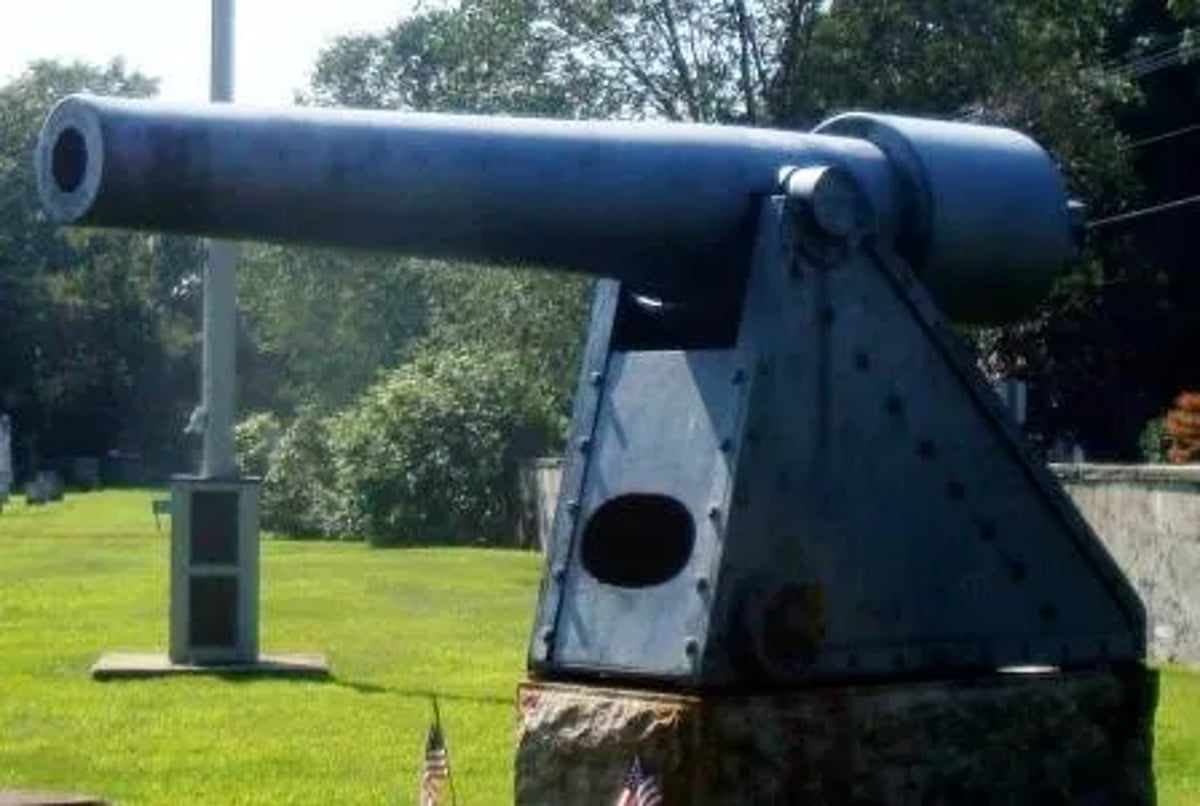

(David Pelland Photos)
6.4-inch 100-pounder Parrott rifle (Parrott, 6.4-inch, rifle, seacoast, Model 1861), weight 9,672-lbs, manufactured in 1863, dedicated in 1902 to honour veterans buried in a section near the gun.
The gun points southeast, and has been mounted on a stone platform inscribed with the initials G-A-R to honour the Grand Army of the Republic, the Civil War veterans’ organization. A plaque on the southwest face bears the dedication “To the memory of those who fought for the preservation of the Union 1861-1865”
Hartford
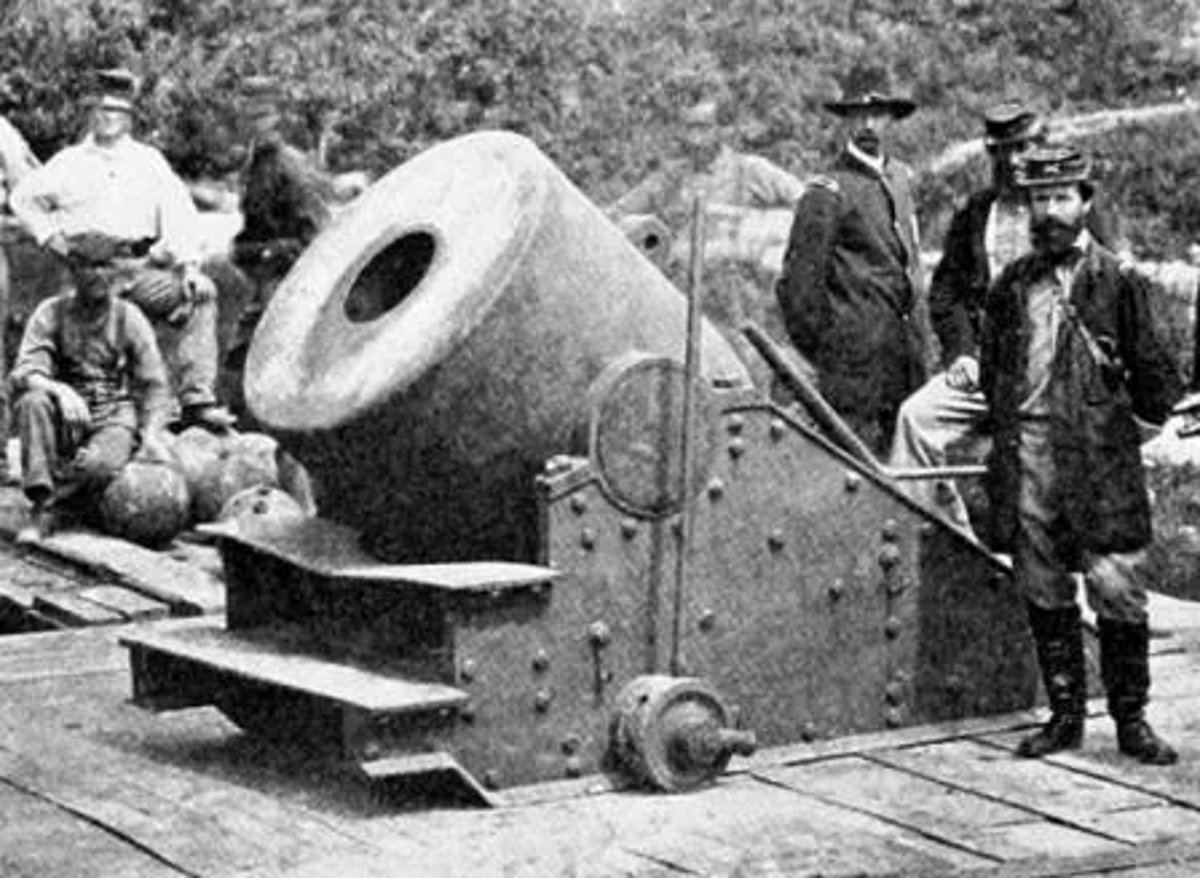
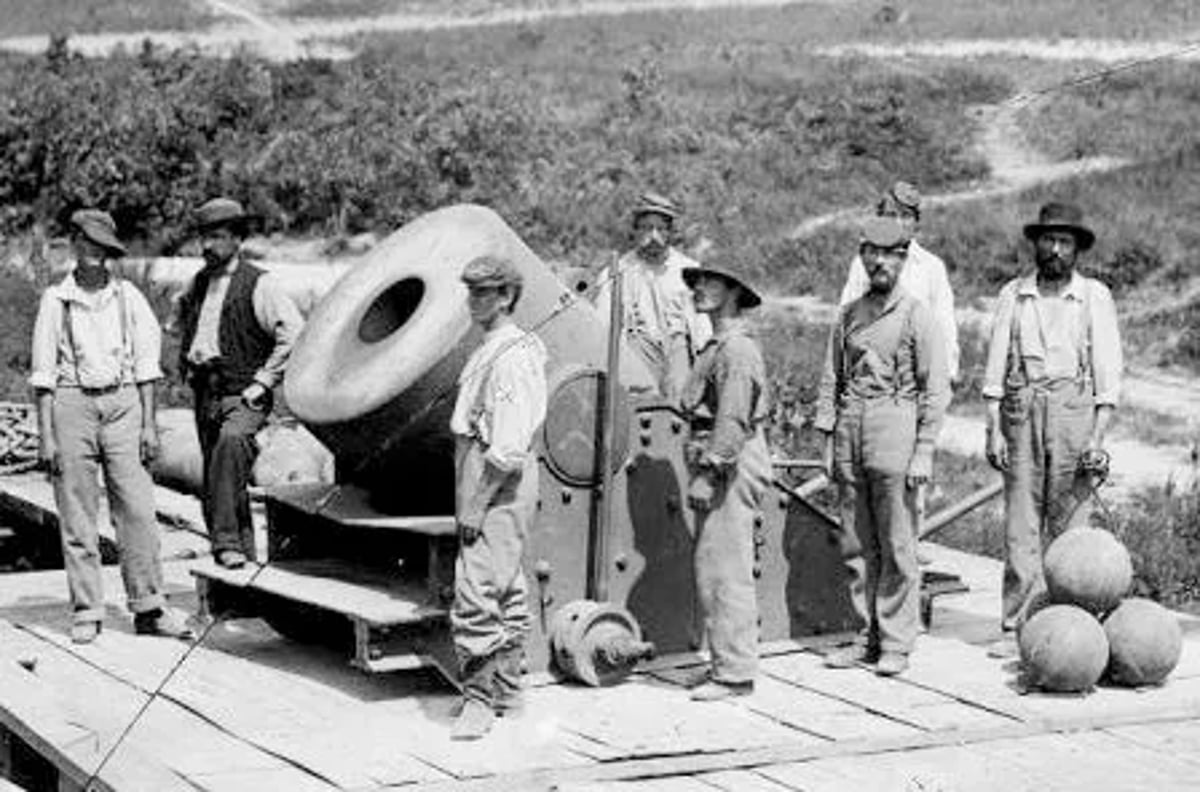
(Library of Congress Photos)
13-inch Seacoast Mortar M1861.



(Dave Pelland Photos)
13-inch Seacoast Mortar, Model 1861, weight 17,196-lbs, Reg. No. 97, Fdy No. 900, 1862, mounted on a stone memorial, nick-named “The Petersburg Express" and "The Dictator”.
This mortar was used by the First Connecticut Heavy Artillery (Civil War) during the campaign at Petersburg, Virginia (1864-1865). The First Connecticut Heavy Artillery, originally the Fourth Connecticut Infantry, was the first volunteer organization that was mustered for three years into the service of the United States (May 22, 1861-September 25, 1865). The mortar stands on a stone monument with three cannon balls in the front and another three in the back. It honours Connecticut's first volunteers of the Civil War. Three inscriptions fastened onto the stone base read: "1st Conn. Heavy Artillery Originally 4th Conn. Infantry Mustered in May 22, 1861. Mustered out Sept. 25 1865. Total enrollment officers and men 3802"; and, "Erected by the survivors and friends of the regiment and the veteran and active companies Hartford City Guard to the first volunteer organization that was mustered for three years into the service of the United States in the War of 1861-1866."; and, "This 13-inch sea coast mortar was in actual use by the regiment during the campaign in front of Petersburg 1864-65 and widely known as the Petersburg Express". It is located on the Hartford-State Capitol Grounds, part of the 1st Connecticut Heavy Artillery Monument.
Although the monument was authorized in 1895 the mortar was not placed here until 1902. The monument was dedicated on September 25th of that year. At the time of donation this mortar was at Fort Monroe, VA. A newspaper article from 13 Nov 1902 states that this mortar is the gun known as the “Petersburg Express”. Another article from the National Tribune of 25 Dec 1902 confirms this and states that the mortar was identified at Fort Monroe by a former crew member by a broken bolt and registration number. It was mounted on a rail car at Petersburg. This gun was long thought to be the “Dictator” used at the siege of Petersburg, VA. Based on the recorded weight of 17,186 lbs for the “Dictator” this has proven not to be the case.

(Jack Photo)

(James Photo)

(Perries Photo )
Quick Firing (QF) Hotchkiss 3-pounder 47-mm Revolving Cannon, 1879, mounted on a wheeled carriage.
This weapon is an early hand-cranked machine gun which could fire exploding shells. It had a Gatling-type revolving barrel machine gun with five barrels, invented in 1872 by Benjamin B. Hotchkiss s(1826–1885), founder of Hotchkiss et Cie. It was a built-up, rifled, rapid-fire gun of oil-tempered steel, having a rectangular breechblock which moved in a mortise cut completely through the jacket. It was designed to be light enough to travel with cavalry, and had an effective range beyond that of rifled small-arms.
The Hotchkiss Revolving Cannon on display inside the Capitol building iwas captured from the wreck of the Spanish armored cruiser Vizcaya after the Battle of Santiago Bay in 1898. The gun was sent back to the States by a Connecticut naval captain, and it was mounted on a Gattling mount for display. Is it missing a few pieces, but is in good shape (having been refurbished by the Colt factory in 1898). It stands in the Hall of Flags.
Hebron

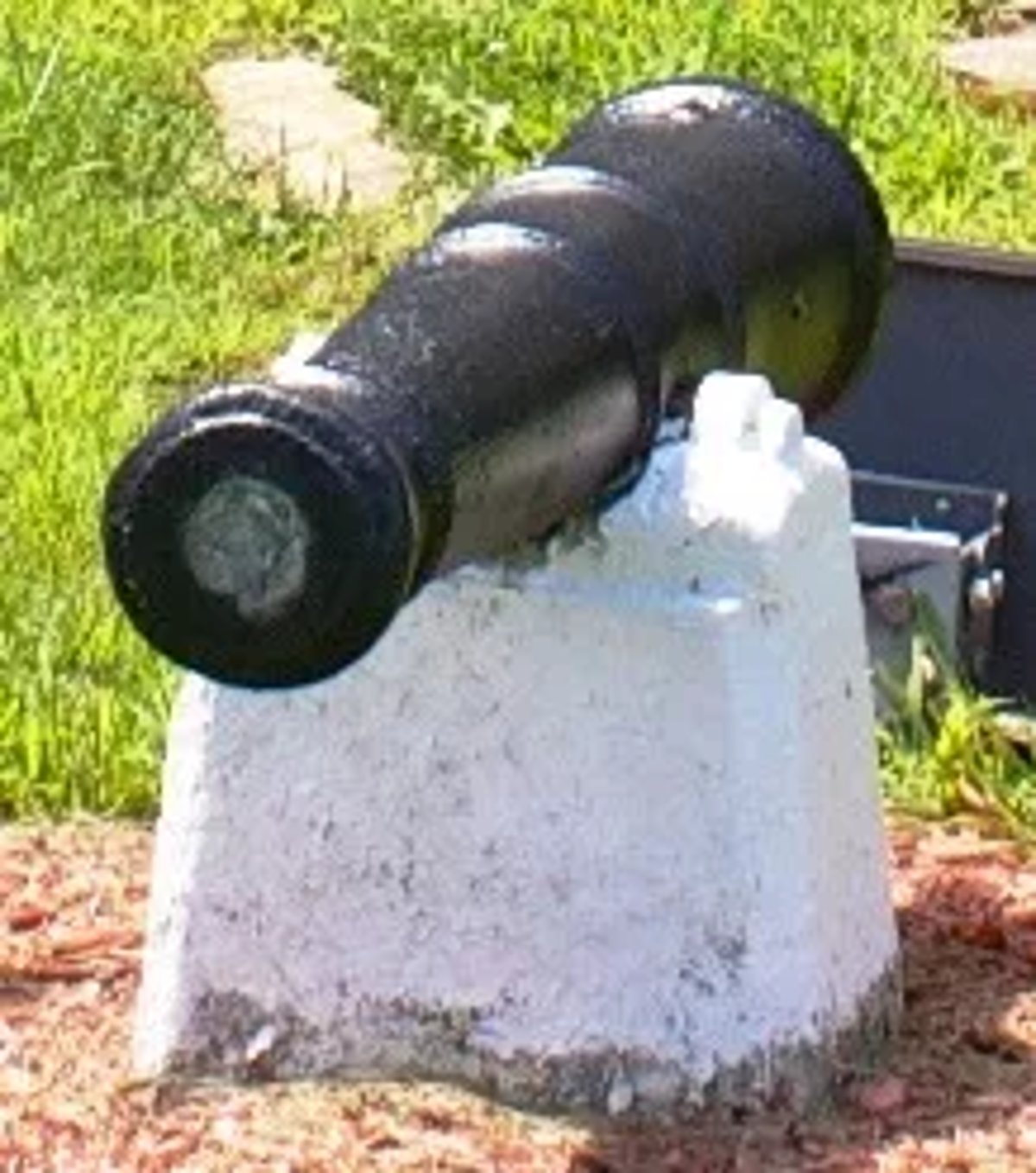
(Dave Pelland Photos)
Cast-iron smoothbore muzzle-loading 6-pounder Gun mounted on a concrete stand, Memorial Green.
Higganum





(Nelson Lawry Photos)
Vickers QF 18-pounder Mk. II, weight 8-2-25 (977 lbs), VSM, King's Arrow, 1918, No. L7765, located on the village green.
Litchfield

(David Pelland Photo)
8-inch Rodman Gun (Columbiad, 8-inch, smoothbore, seacoast, Model 1844), weight 9,240-lbs, mounted on a concrete stand beside the Civil War memorial in the Town Square.
Cast-iron smoothbore muzzle-loading Mortar, mounted in front of the American Legion post.
Middletown

(Joe Mabel Photo)
Bronze 12-pounder Napoleon Model 1857 smoothbore muzzle-loading Gun-Howitzer, (Confederate Gun with straight muzzle used in the Civil War), No. 1 of 4. Soldier's Monument in the Town Square.

(Dave Pelland Photo)
Bronze 12-pounder Napoleon Model 1857 smoothbore muzzle-loading Gun-Howitzer, (Confederate Gun with straight muzzle used in the Civil War), No. 2 of 4. Town Square.
Bronze 12-pounder Napoleon Model 1857 smoothbore muzzle-loading Gun-Howitzer, (Confederate Gun with straight muzzle used in the Civil War), No. 3 of 4. Town Square.

(Metals - Conserve Art Photo)
Bronze 12-pounder Napoleon Model 1857 smoothbore muzzle-loading Gun-Howitzer, (Confederate Gun with straight muzzle used in the Civil War), No. 4 of 4. Town Square.

(Dave Pelland Photo)
8-inch Siege and Garrison Mortar, No. 1 of 2. Veterans Memorial Hall.
8-inch Siege and Garrison Mortar, No. 2 of 2. Veterans Memorial Hall.
Milford

(Town of Milford Photo)
Civil War Gun mounted on a wheeled carriage in front of the Taylor building.
Moosup

(The Dastardly Canuck Photo)
M60A3 Main Battle Tank (Serial No. 3801A), RN 09A08171, Moosup Park, 121 Main St.
Mystic Seaport

(Library of Congress Photo)
4.2-inch 30-pounder Parrot Rifle, 1st Connecticut Artillery, Civil War era.

(Jean B. Evans Photo)

(Ad Meskens Photo)
4.2-inch 30-pounder Parrot Rifle, mounted on a concrete stand at the Denison Burial Ground on Route 1.
Bronze 6-pounder James Rifle, dated 1864 (TBC), No. 1 of 2.
Bronze 6-pounder James Rifle, dated 1864 (TBC), No. 2 of 2.
The James Rifle is a generic term to describe any artillery gun rifled to the James pattern for use in the American Civil War. Charles T. James developed a rifled projectile and rifling system. Early in the war there were many 6-pounder bronze guns in service with the field artillery and few rifled pieces available. A number of these guns were rifled to fire the 3.67" caliber James projectile. These are classified as "rifled 6-pounder guns" or alternately as 12-pounder James rifles. James worked with Ames Manufacturing Company, Chicopee, Massachusetts to produce 3.80" bore rifled cannon in at least six known variants. Collectively these are referred to as 14-pounder James rifles. The initial type was reaming of existing 6-pounder Model 1841 guns to 3.80", then rifling. This eliminated any deviations from tube wear--a common problem with bronze cannon that had already seen service. The other five types were new pieces all using the smooth curves of the Ordnance profile. The first five variants were bronze, while the final type was iron.

(Sara Photo)
Cast-iron smoothbore muzzle-loading Gun mounted on a wood naval gun carriage, No. 1 of 3 in a small park near the harbour.
Cast-iron smoothbore muzzle-loading Gun mounted on a wood naval gun carriage, No. 2 of 3 in a small park near the harbour.
Cast-iron smoothbore muzzle-loading Gun mounted on a wood naval gun carriage, No. 3 of 3 in a small park near the harbour.
New Canaan





(Valerie Bueti Photos)
4.5-inch Blakely siege and naval rifle, Serial No. 162. (Register of Surviving Civil War Artillery, Jim Bender via John L. Morris). Blakely PATENT 1862.
In a newspaper article published on 24 May 1923 to mark the day of the dedication, the writer noted, "The parade will then be reformed, and will march to the Town Hall, near which building the formal presentation will be made by the Veterans of Foreign Wars to the members of the Grand Army of the Republic, of a gun that was in service during the war for the Union. This relic of a great conflict that nearly tore the country asunder will be a constant reminder to the present and future generations of the Civil War, and especially of New Canaan's sons who were fighting under the Stars and Stripes three-score years ago."
The Blakely rifle or gun is the name of a series of rifled muzzle-loading cannon designed by British army officer Captain Theophilus Alexander Blakely in the 1850s and 1860s. Blakely was a pioneer in the banding and rifling of cannon but the British army declined to use Blakely's design. The guns were mostly sold to Russia and the Confederacy during the American Civil War. Blakely rifles were imported by the Confederacy in larger numbers than other Imported English cannon. The State of Massachusetts bought eight 9 in (23 cm) and four 11 in (28 cm) models. Blakely rifles had innovative design features using two layer construction and layers of rings which allowed rifling of larger cannons. Blakely's manufacturing innovations allowed larger guns of lighter weight and greater resistance to explosion. The Confederacy used the Blakely rifles in seacoast fortifications, fortifications at Vicksburg, as naval guns and, in the smaller sizes, as artillery in land battles.
New Haven



(Dave Pelland Photos)
Bronze 12-pounder Dahlgren light boat howitzer, No. 1 of 4. 6th Street and Howard.
Bronze 12-pounder Dahlgren light boat howitzer, No. 2 of 4. 6th Street and Howard.
Bronze 12-pounder Dahlgren light boat howitzer, No. 3 of 4. 6th Street and Howard.
Bronze 12-pounder Dahlgren light boat howitzer, No. 4 of 4. 6th Street and Howard.
New London, Fort Trumbull

(Michael Hotaling Photo)
Fort Trumbull is currently a state park. In 1775 Governor Jonathan Trumbull recommended the building of a fortification at the port of New London to protect the seat of the government of Connecticut. Built on a rocky point of land near the mouth of the Thames River on Long Island Sound, the fort was completed in 1777 and named for Governor Trumbull, who served from 1769 to 1784. On 6 September 1781 during the American Revolutionary War, the fort was attacked and captured by British forces under the command of Benedict Arnold, then serving as a brigadier general in the British Army, led a raid on Groton and New London, Connecticut. Two bodies of troops were landed on either side of the mouth of the Thames River and marched towards Fort Trumbull and Fort Griswold in Groton. Fort Trumbull fell after little resistance but about 150 Connecticut militiamen made a gallant stand at Fort Griswold. The British were able to enter the fort and the militia commander, Lieutenant Colonel William Ledyard, offered Major Bromfield, the British commander on the scene, his sword as a token of surrender. According to contemporary accounts, the Bromfield then killed Ledyard with his own sword and the British proceeded to massacre the surviving defenders. Eighty five of the militiamen were killed and the others were either severely wounded, taken prisoner or managed to escape. After the capture of both forts, the British proceed to burn New London and Groton and returned to their ships.
Under the second systems of US fortification, ca 1809, the fort was redesigned and rebuilt to meet changing military needs. First a redoubt was built at the site to react to threat of British attack. Secretary of War Henry Dearborn's report on fortifications for December 1811 describes the fort as "an irregular enclosed work of masonry and sod, mounting 18 heavy guns [with] a brick barracks for one company...". The present fortification replaced the older fort, and was built between 1839 and 1852 as a five-sided, four-bastion coastal defense fort. The new fort could accommodate 42 guns, plus 10 additional guns in two flanking batteries outside the fort. The new fort was built under the supervision of Army engineer George Washington Cullum, who later served as superintendent of the United States Military Academy at West Point, New York.
During the American Civil War, Fort Trumbull served as an organizational center for Union troops and headquarters for the 14th US Infantry Regiment. Here, troops were recruited and trained before being sent to war. Fort Trumbull was briefly commanded by John F. Reynolds who rose to rank of major general and was killed at the Battle of Gettysburg in 1863.
After the Civil War Fort Trumbull was improved by having more modern artillery pieces installed. In the early 1900s several more modern Endicott era fortifications were built to defend Long Island Sound. Fort Trumbull served as the headquarters of these forts until it was given to the Revenue Cutter Service (later renamed the Coast Guard) in 1910 for use as the Revenue Cutter Academy which was renamed the United States Coast Guard Academy in 1915. The Coast Guard Academy moved to its current location in New London in 1932. Fort Trumbull served as the Merchant Marine Officers Training School from 1939–1946 and trained most of the Merchant Marine officers who served during the Second World War. During that war, Fort Trumbull hosted an office of Columbia University's Division of War Research, which developed passive sonar systems. (Wikipedia)

(Roddy Pfeifer Photo)
8-inch Rodman Gun (Columbiad, 8-inch, smoothbore, seacoast, Model 1844), weight 9,240-lbs, converted rifle mounted on an iron gun carriage, No. 1 of 2.

(Roddy Pfeifer Photo)
8-inch Rodman Gun (Columbiad, 8-inch, smoothbore, seacoast, Model 1844), weight 9,240-lbs, converted rifle mounted on an iron gun carriage, No. 2 of 2.
New London
Bronze 12-Pounder Dahlgren light boat howitzer, Serial No. 176, made at the US Navy Yard Washington. This gun is located on the corner of Garfield Avenue and Williams Street.
New London, U.S. Coast Guard Academy
4-inch 20-pounder Dahlgren Boat Howitzer.
24-pounder Dahlgren Boat Howitzer.
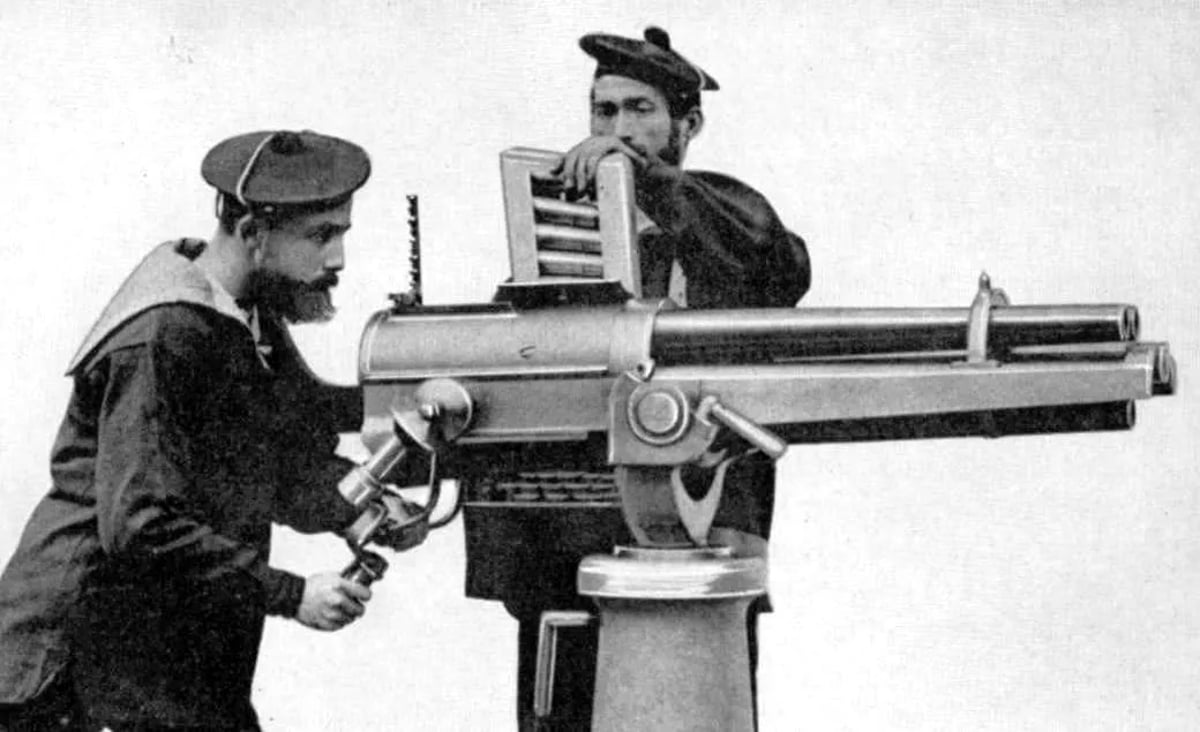

(HyperWar Foundation Photos)
37-mm 5-barrelled Hotchkiss Revolving Cannon mounted on a USN warship.
37-mm 5-barrelled Hotchkiss Revolving Cannon, No. 1 of 4.
37-mm 5-barrelled Hotchkiss Revolving Cannon, No. 2 of 4.
37-mm 5-barrelled Hotchkiss Revolving Cannon, No. 3 of 4.
37-mm 5-barrelled Hotchkiss Revolving Cannon, No. 4 of 4.

(USCG Photo)
3-pounder saluting gun Model 1904, No. 1 of 2.
3-pounder saluting gun Model 1904, No. 1 of 2.
New Milford
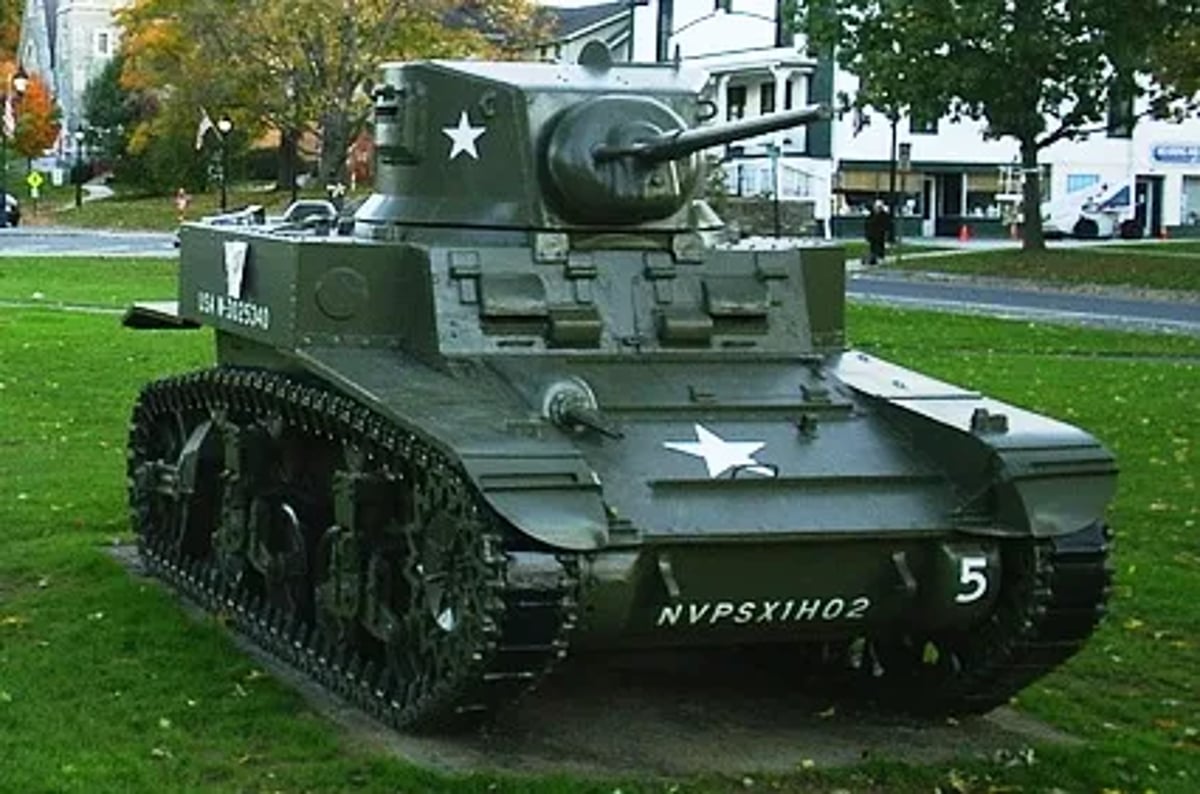
(city-data Photo)
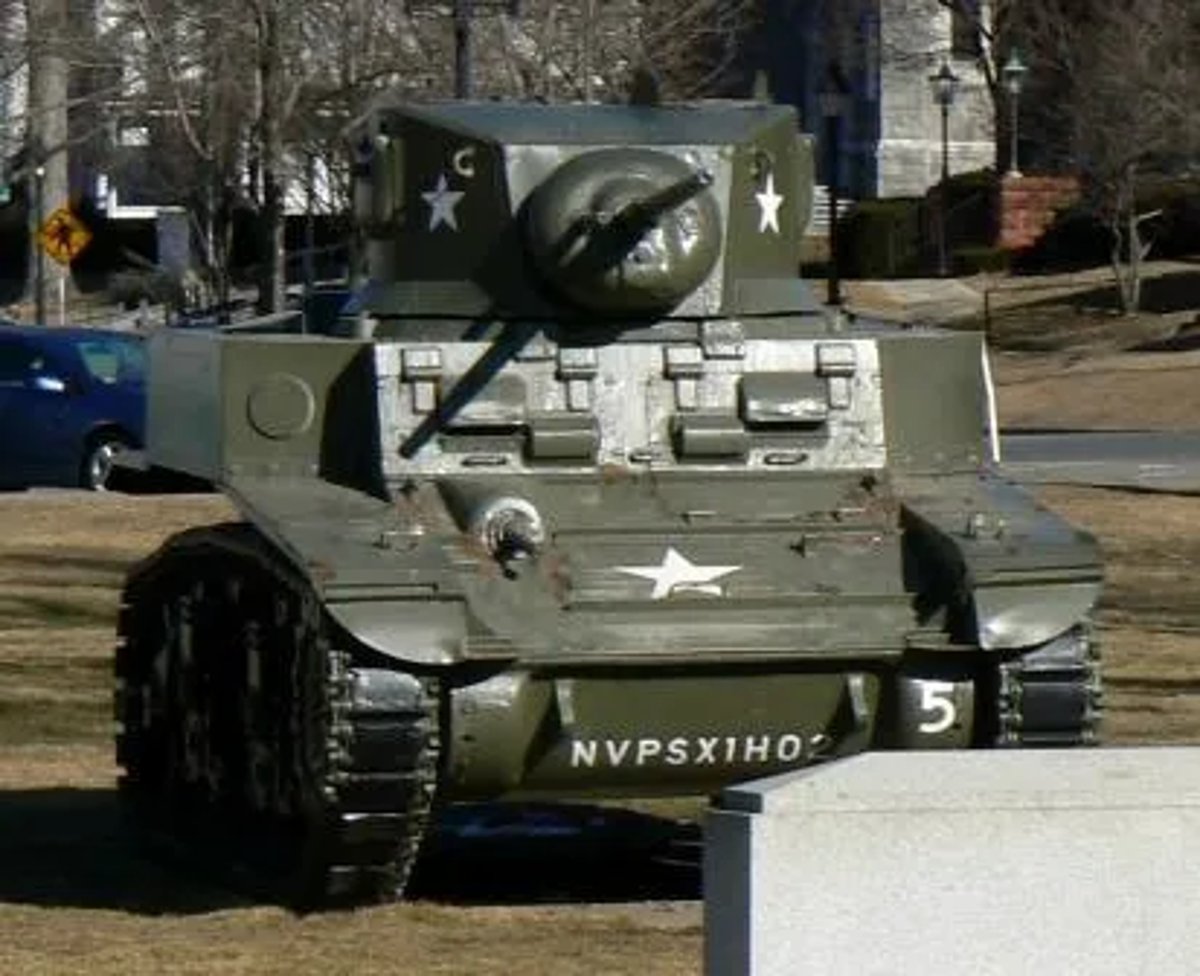
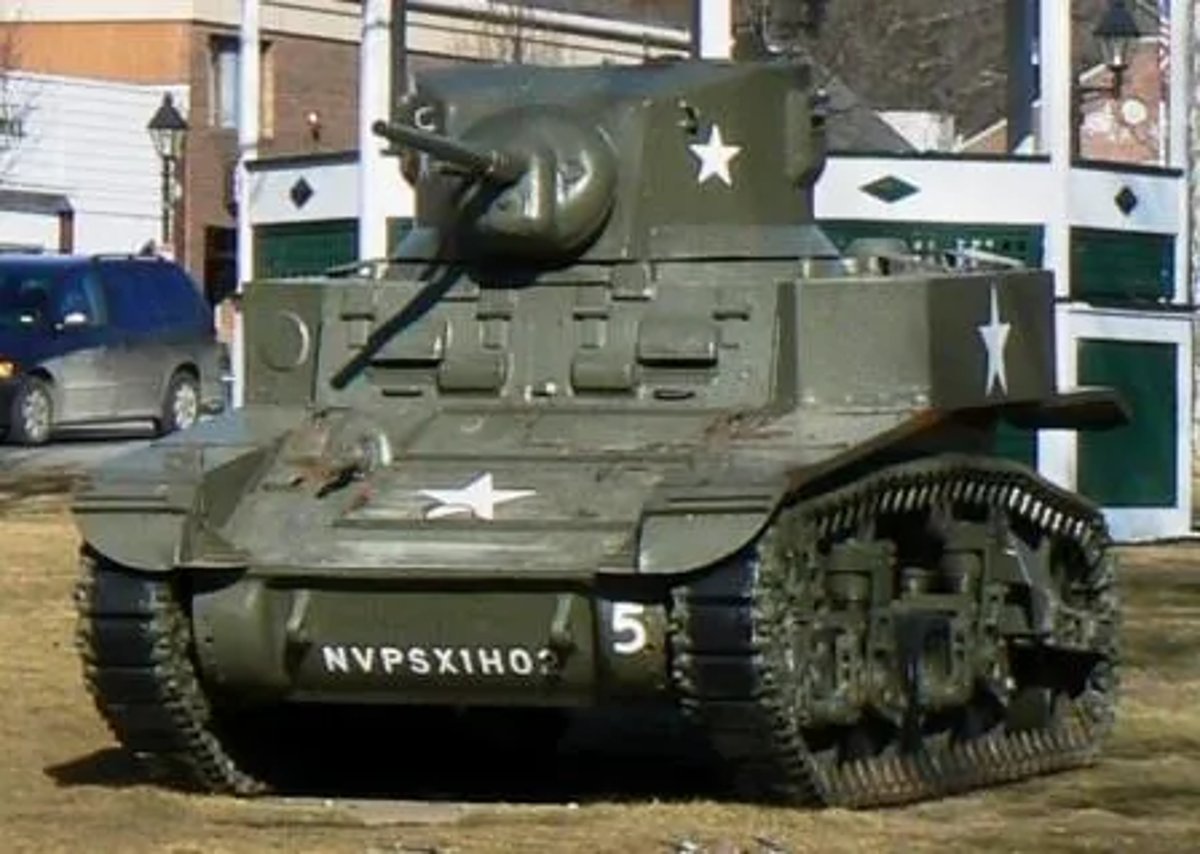

(David Pelland Photos)
M3A1 Stuart Light Tank (Serial No. 10130), New Milford Second World War Memorial, Town Green, in place since 1948.
New Preston

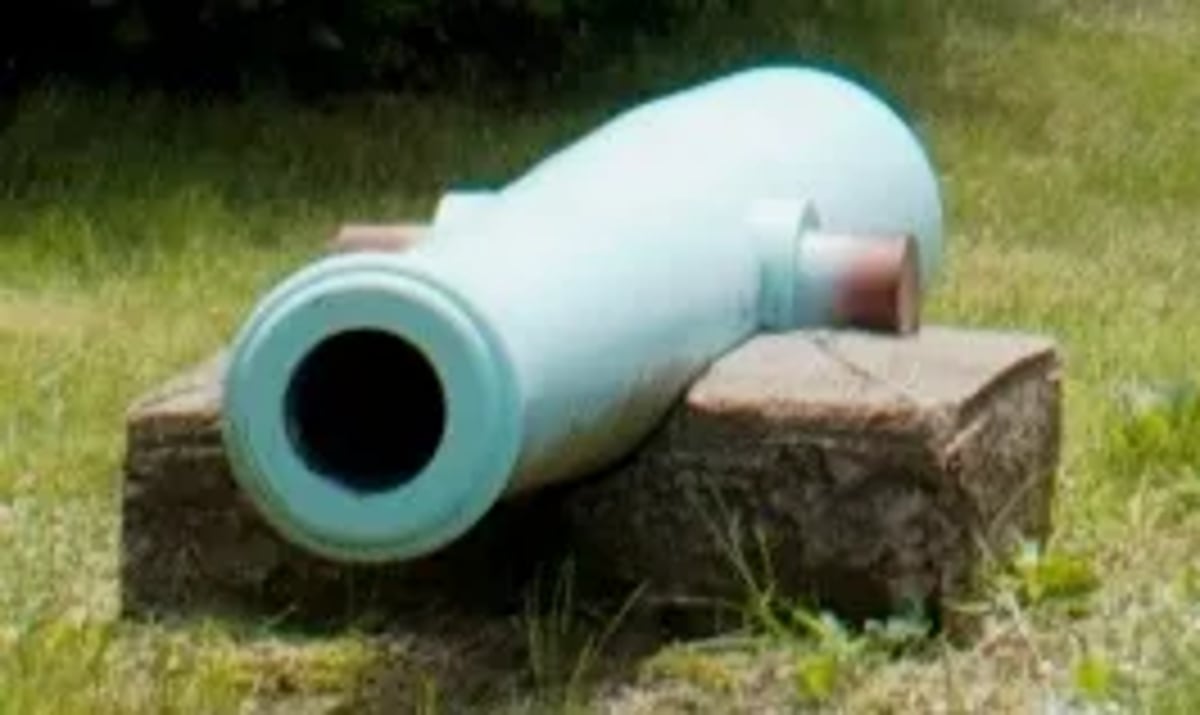
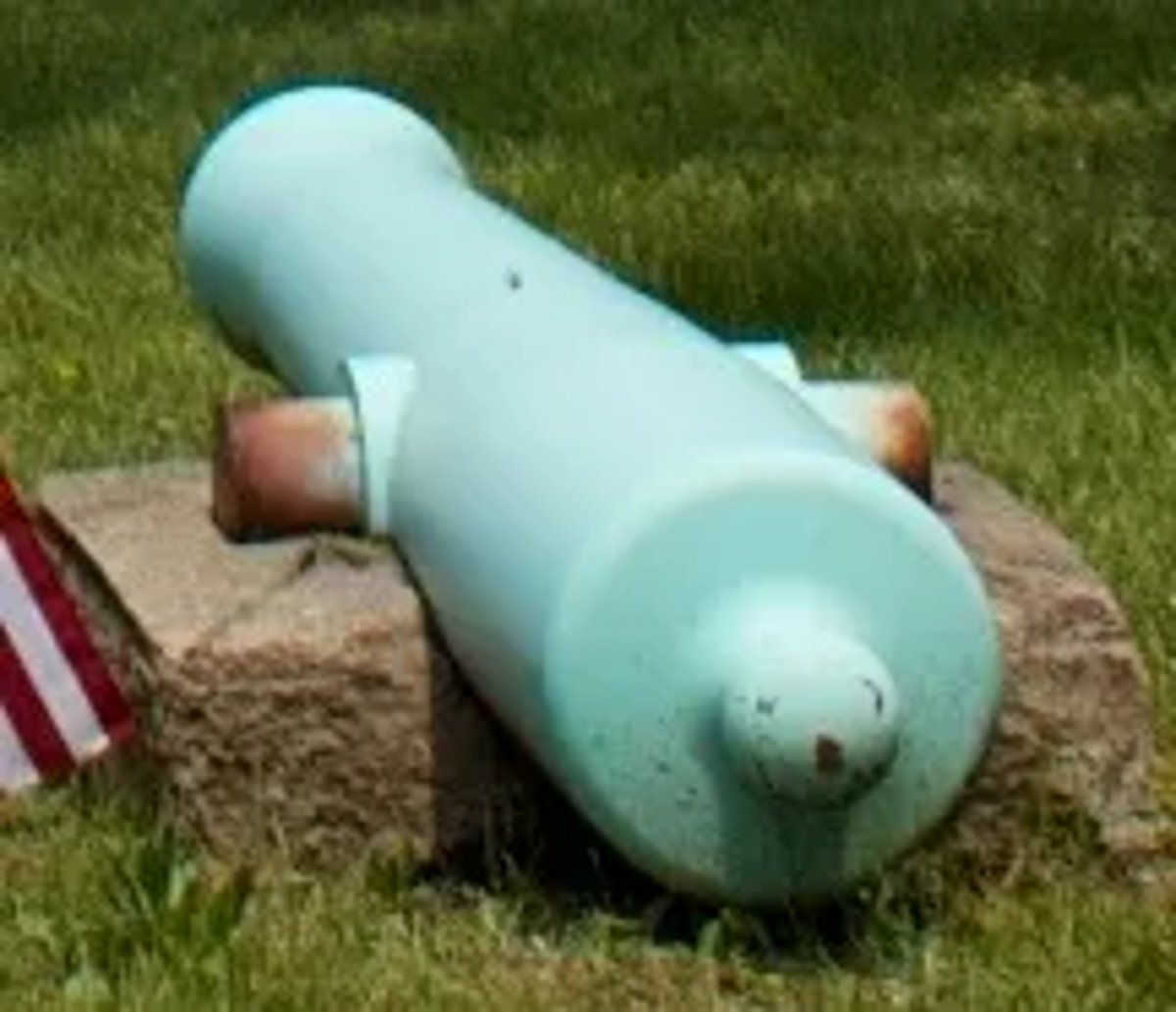

(Dave Pelland Photos)
Civil War Gun, New Preston Military Cemetery.
North Haven




(David Pelland Photos)
10-inch Rodman Gun, (Columbiad, 10-inch, smoothbore, seacoast, Model 1861), weight 14,980-lbs, 1867, mounted on an iron gun carriage on a stone based monument honoring Civil War veterans.
A dedication on the base’s front (west) face reads, “Erected by the town of North Haven as a tribute to the valor of her sons who on land and sea fought in the Civil War to preserve the Union.” The east face lists the monument’s 1905 dedication date and honors the battles of Cedar Mountain, Fort Wagner, Fredericksburg, Fort Gregg, and Petersburg (all in Virginia). The gun and monument is on the green across from its 1886 Memorial Town Hall. This cannon was manufactured in 1867 at the Fort Pitt Foundry in Pittsburgh, and was one of four installed at Lighthouse Point in New Haven. Another Lighthouse Point cannon stands as a Civil War monument on the East Haven green. Another that stood near Milford’s Soldiers’ and Sailors’ Monument was lost to a Second World War scrap drive, and the fate of the fourth cannon is unknown.
Norwalk

French de Bange 155-mm long cannon mle. 1877 (155 L de Bange) field gun, captured by the Germans and put into service on the Western Front, captured again, this time by the Canadians. (Library and Archives Canada Photo, MIKAN No. 3397890),

French de Bange 155-mm long cannon mle. 1877 (155 L de Bange) field gun, captured by the Germans and put into service on the Western Front, captured again, being examined by Canadians, Amiens, France, Aug 1918. (Library and Archives Canada Photo, MIKAN No. 35222222)




(David Pelland Photos)
French de Bange 155-mm long cannon mle. 1877 (155 L de Bange) field gun, mounted on top of the First World War monument on the city’s green.
This gun had been captured by German forces in the First World War and recaptured by the French. It was presented as a gift to the city of Norwalk in 1921. The gun stood atop the monument until the monument was moved in 1949 from Belden Avenue to its present home at the intersection of East Avenue and Park Street. At that time, the cannon was shifted to a former VFW building, until it was restored and replaced on the original monument. The monument has eight bronze plaques bearing the monument’s dedication as well the names of local residents who fought and died in the First World War.
French de Bange 155-mm long cannon mle. 1877 (155 L de Bange) field gun, obsolete by the beginning of the First World War, the 155 L was nonetheless pressed into service and became the main counter-battery piece of the French army in the first two years of the war.
Norwich

(The Distracted Wanderer Photo)

(Connecticut Diaries Photo)
Bronze 6-pounder gun mounted on a wheeled carriage in front of the Buckingham Memorial, Sedgwich Post No. 1, Grand Army of the Republic (GAR).



(Dave Pelland Photos)
4.2-inch 30-pounder Parrot Rifle, Civil War Gun marked 4235 ATo. 149, 1862, WPH, AM 42 on the muzzle, mounted on an iron gun stand, Andersonville Memorial, Yantich Cemetery.

(Library and Archives Canada Photo, MIKAN No. 3397887)
German First World War 15-cm sFH 02 Howitzer, captured at Amiens, France, Aug 1918.

(Dale Plummer Photo)
German First World War 15-cm sFH 02 Howitzer, originally on display on the Chelsea Parade Green, now in Mohegan Park.
Plainfield

(Johnna Kaplan Photo)


(CT Bruce Photos)
M5A1 Stuart Light Tank, Plainfield Veterans Park.
Plainville

(Dave Pelland Photo)
3-inch Ordnance Rifle, Model 1861, Civil War era, mounted on a concrete stand, Veteran's Memorial Park.
Portland


(Dave Pelland Photos)
3-inch Ordnance Rifle, Model 1861, Civil War era, No. 1 of 2, TTSL, No. 110, PICo, 1861, weight 811 lbs on the muzzle, mounted on a concrete stand on a triangular green at the intersection of Main Street (Route 17) and Bartlett Street.
3-inch Ordnance Rifle, Model 1861, Civil War era, No. 2 of 2, standing on a triangular green at the intersection of Main Street (Route 17) and Bartlett Street.
Preston

(Dave Pelland Photo)
8-inch Siege and Garrison Mortar, No. 1 of 2, Civil War Memorial, Jewett City Road, Route 165.
8-inch Siege and Garrison Mortar, No. 2 of 2, Civil War Memorial, Jewett City Road, Route 165.
Redding, Putnam Memorial State Park
.avif)
.avif)
.avif)
(Valerie Bueti Photos)
14-pounder bronze James Rifle, Serial No. 83, 1862, inside the museum. Designed by General Charles T. James Made in Chicopee, Massachusetts Ames Manufacturing Company. This gun was used by the 2nd Connecticut Light Battery Volunteers, "Sterling's Battery", activated In Bridgeport, Connecticut and consisting of: four 14 Pound James Rifles & two 12 Pound Howitzers. This gun was used in the Battle of Gettysburg (McPherson's Farm & Oak Ridge), Fort Morgan, Gasque, AL Fort Gaines, Gasque, AL & Blakeley, Mobile, Alabama.
.avif)
.avif)
.avif)

.avif)
.avif)
(Valerie Bueti Photos)
There are four possibly 32-pounder Model 1864 (6.2-inch) Dahlgren Shell Guns, with a weight of about 4,500 lbs each, on display outside on the grounds of Putnam Memorial State Park.
Rowayton



(David Pelland Photos)
6.4-inch 100-pounder Parrott rifle (Parrott, 6.4-inch, rifle, seacoast, Model 1861), weight 9,672-lbs, dedicated in 1901 to honor local Civil War veterans. A dedication engraved on the front (north) face of the monument’s base reads, “Memorial gun. Reminding us of the heroic deeds of our soldiers and sailors of the Republic in the War of the Rebellion for the preservation of the Union. Erected 1901. This gun came from the USS Tallapoosa.”
Scotland
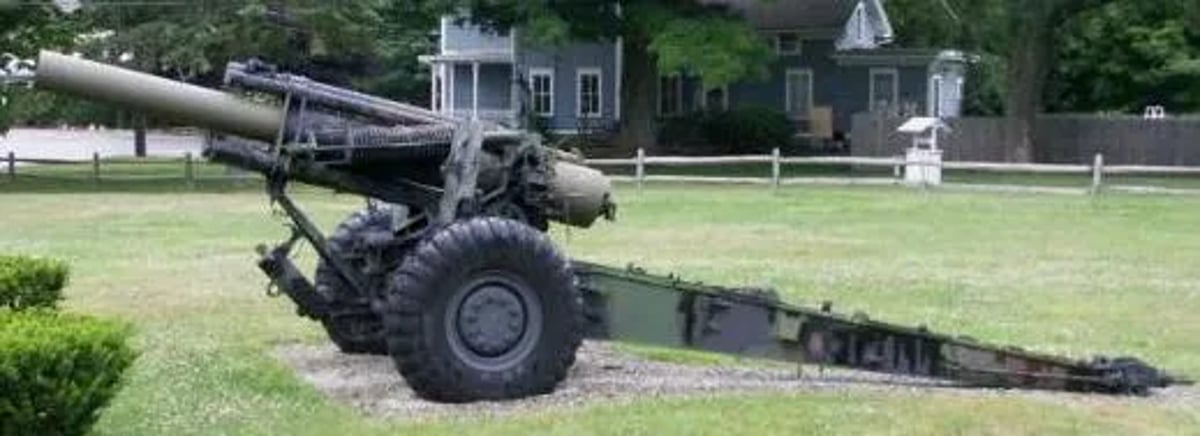
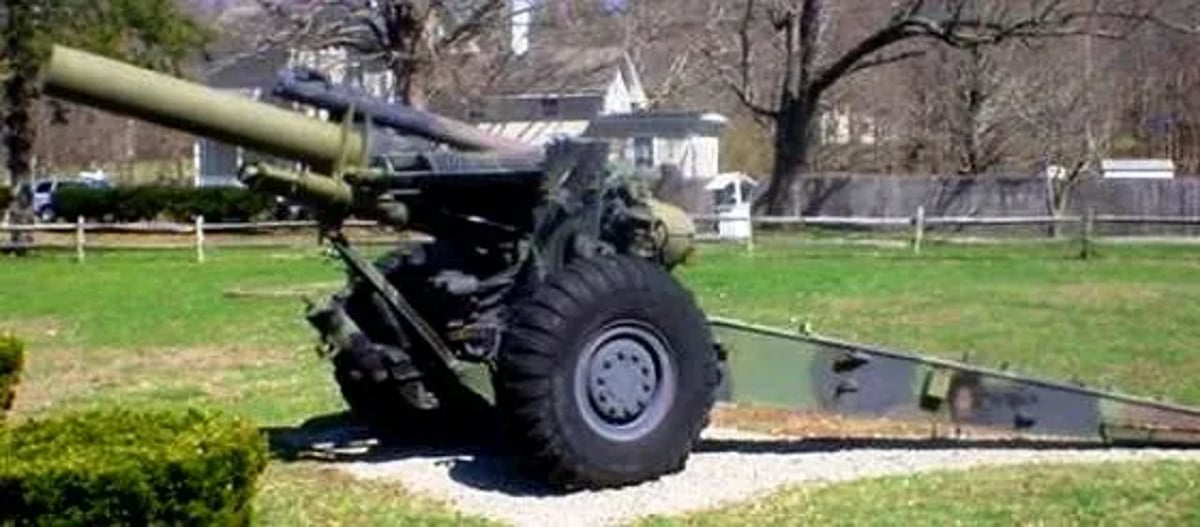
(CraiginCT Photos)
US 155-mm Howitzer, M114A2 carriage Serial No. 5499, dated 1956, SJS. Located near the town center.
Seymour

(David Pelland Photo)
4.2-inch 30-pounder Parrot Rifle, mounted on a concrete stand, No. 1 of 3. Three of the four corner positions around the Soldiers Monument, French Memorial Park Spruce Street, are occupied by 11 ft. 4 in. long cannon mounted on cut stone. The fourth corner has a triangular pile of cannonballs on a cut stone base.

(David Pelland Photo)
4.2-inch 30-pounder Parrot Rifle, mounted on a concrete stand, No. 2 of 3, 1864 by the West Point Foundry in Cold Spring, N.Y. Soldiers Monument, French Memorial Park Spruce Street.
4.2-inch 30-pounder Parrot Rifle, mounted on a concrete stand, No. 3 of 3. Soldiers Monument, French Memorial Park Spruce Street.
Stafford

(David Pelland Photo)
57-mm M1A1 Anti-tank Gun, Stafford Wall of Honor.
Stafford Springs
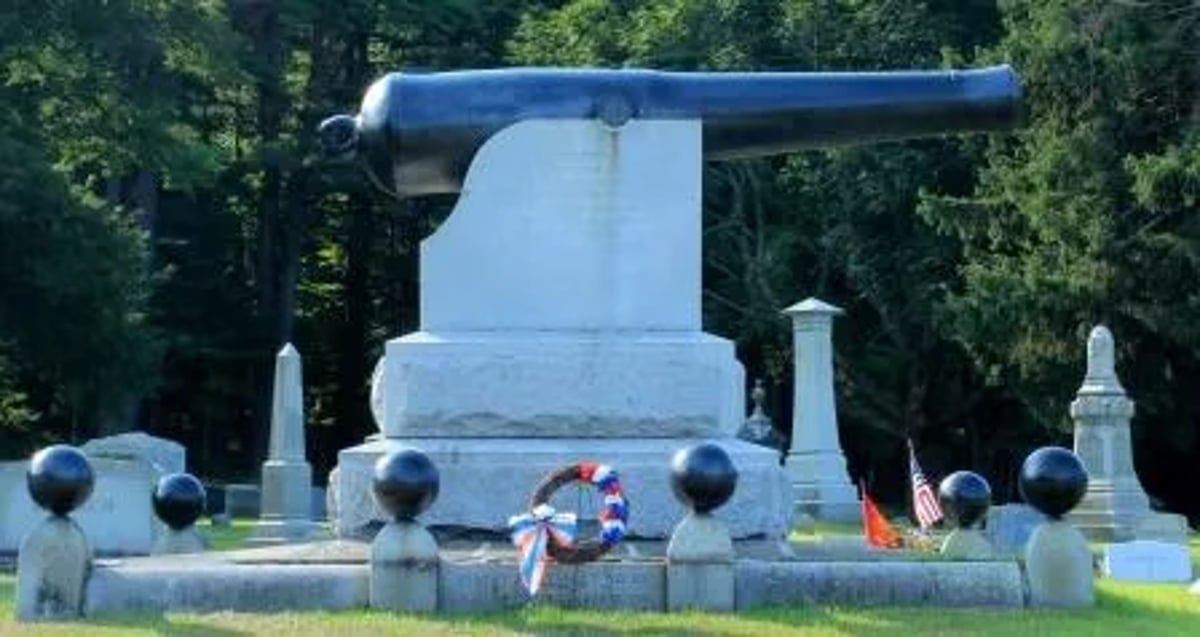
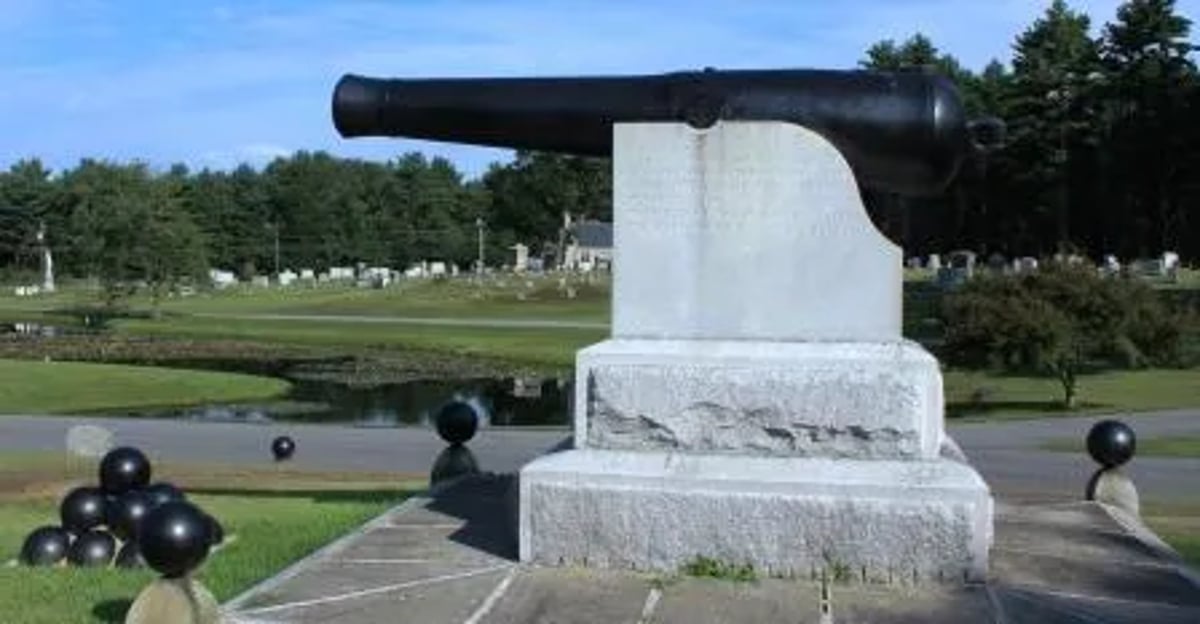



(Dave Pelland Photos)
32-pounder Model 1864 (6.2-inch) Dahlgren Shell Gun, 4,500 lbs, mounted on a concrete memorial in Stafford Springs Cemetery on Monson Road (Route 32).
This 32-pounder Model 1864 (6.2-inch) Dahlgren Shell Gun, 4,500 lbs, was dedicated in 1897, and bears an inscription on its south (left) face reading, “A tribute to the patriotism of the men who went to the defence of the country from Stafford in the War of the Rebellion. The present bequeaths to the future the remembrance of the heroic past.” The west face has an inscription reading, “Veterans 1861-1865.” The north face bears an inscription reading, “Erected by Winter Post No. 44, G.A.R., assisted by the Woman Relief Corps, and the Sons of Veterans in honor of their comrades. Dedicated 30 May 1897.”
Stonington Village
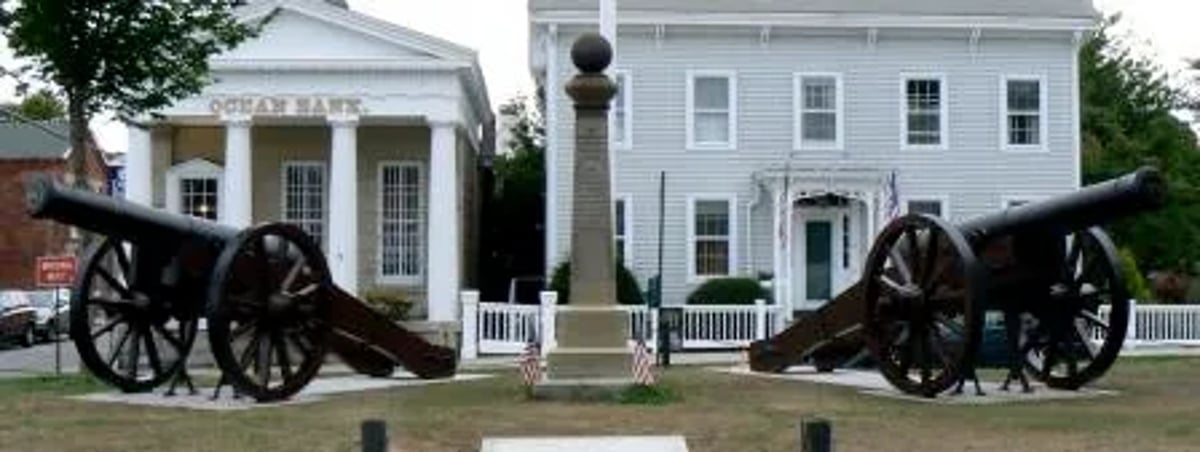
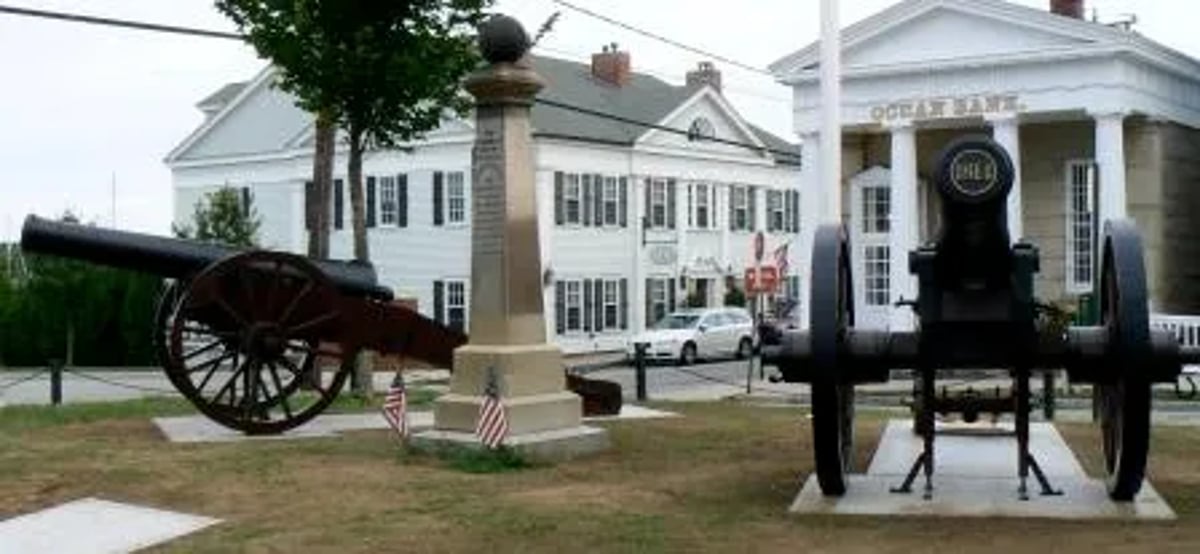
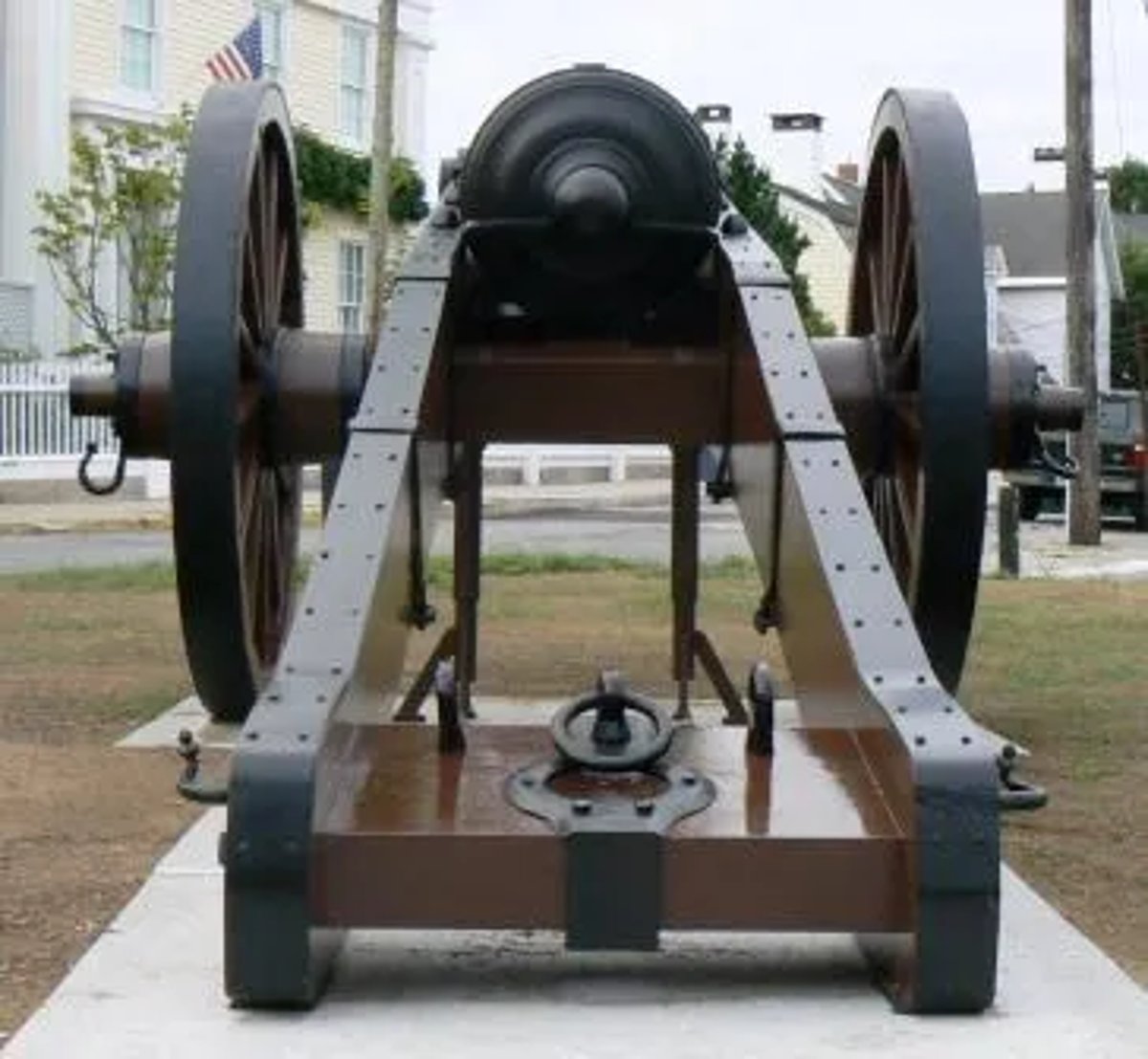
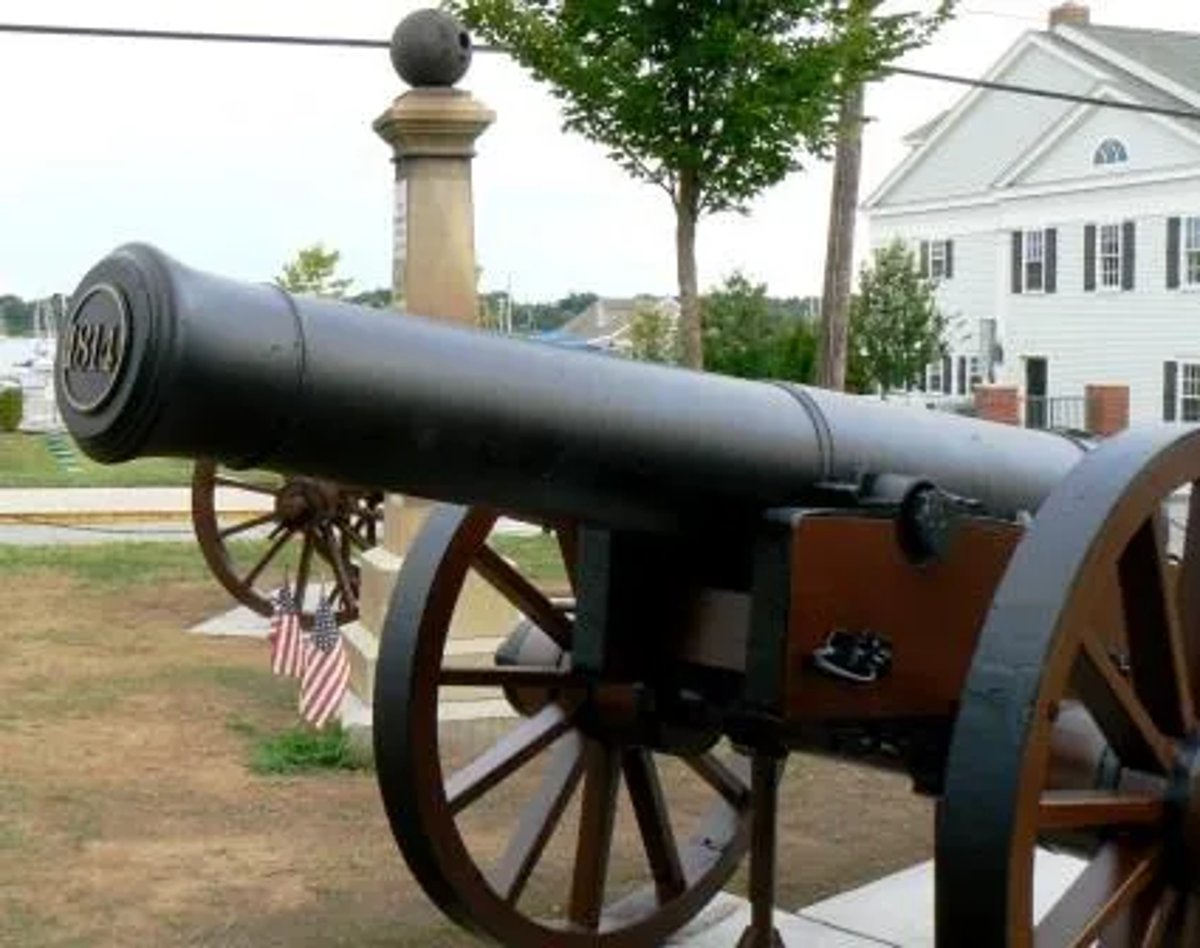
(David Pelland Photos)

(Waymarking Photo)
Cast-iron smoothbore muzzle-loading 18-pounder Gun, 35 cwt, No. 1 of 2, flanking an historical marker in the center of Cannon Square.

(Coastal Connecticut Life Photo)
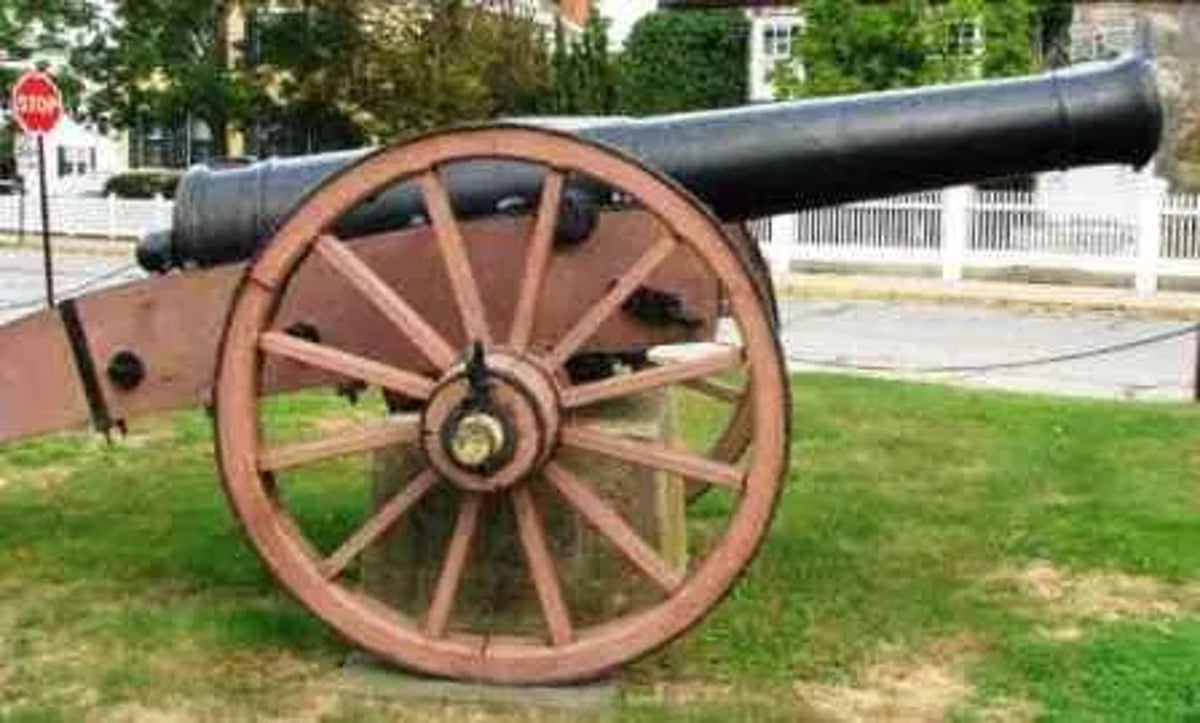
(Friends of Fort Washington Photo)
Cast-iron smoothbore muzzle-loading 18-pounder Gun, 35 cwt, No. 2 of 2, cast in Salisbury, Connecticut, flanking an historical marker in the center of Cannon Square.
The 1830 obelisk, topped with a naval shell, stands in the borough of Stonington’s Cannon Square. An inscription on the monument’s north face reads, “These two guns of 18 pounds caliber were heroically used to repel the attack on Stonington of the English naval vessels Ramilies, 74 guns, Pactolus, 44, Dispatch, 20, Nimrod, 20 and the bomb ship Terror, 10 August 1814.”
Suffield

(Dave Pelland Photo)
Cast-iron smoothbore muzzle-loading possibly 24-pounder Gun, mounted on a concrete stand behind the Civil War Memorial.
Tavern Island
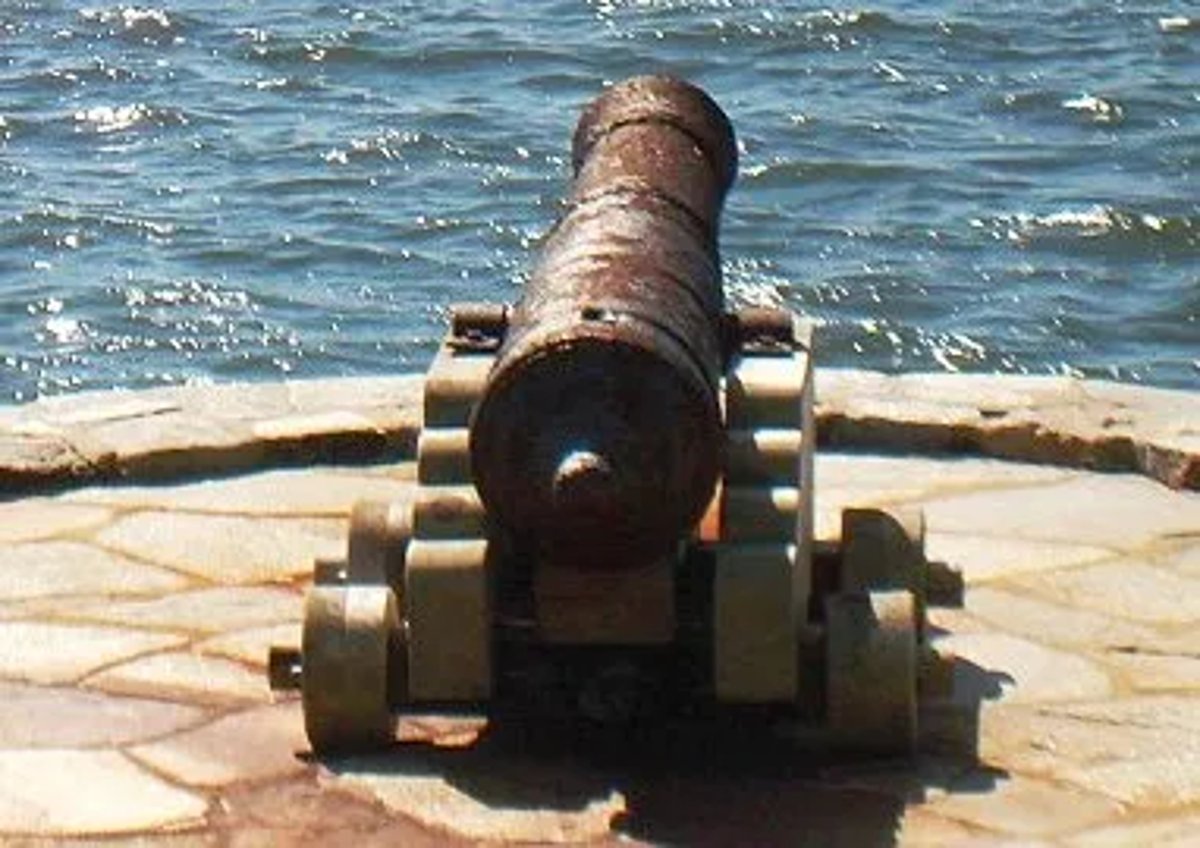
(Mercury Press Photo)
Cast-iron smoothbore muzzle-loading possibly 24-pounder gun mounted on a wood naval gun carriage, heavily corroded.
Terryville
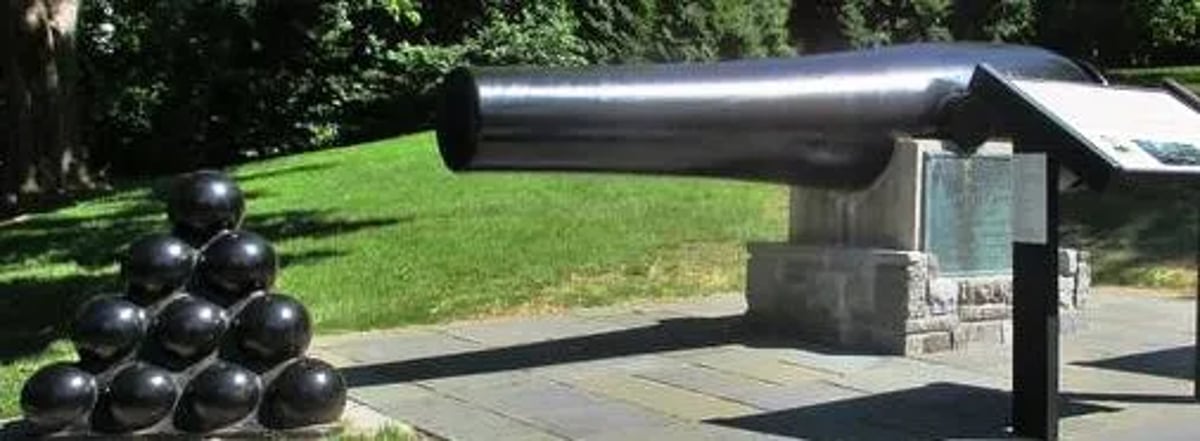

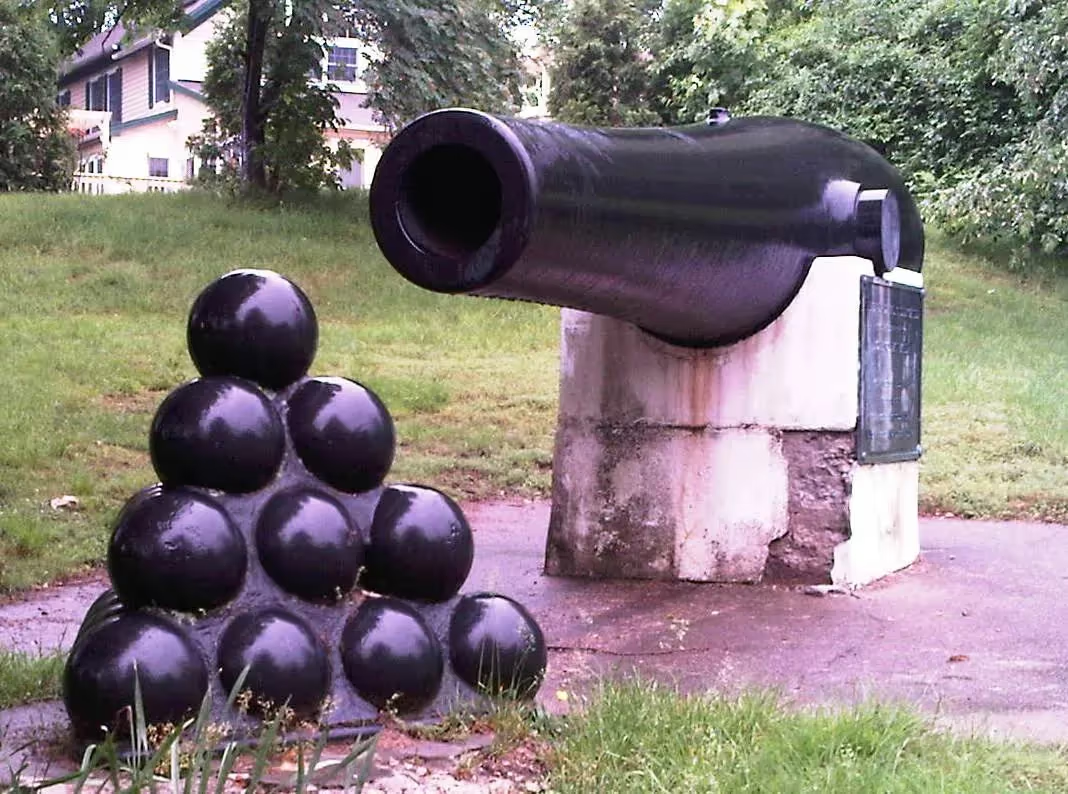

(John Banks Photos)
10-inch Rodman Gun, (Columbiad, 10-inch, smoothbore, seacoast, Model 1861), weight 14,980-lbs, No. 631 FPF, PA149, 9987 on the muzzle, mounted on a concrete stand.
Thomaston

(Dave Pelland Photo)
Possibly a Bronze 12-pounder Napoleon Model 1857 smoothbore muzzle-loading Gun-Howitzer, (Confederate Gun with straight muzzle used in the Civil War), mounted on a wheeled gun carriage beside the Civil War memorial.

(Dave Pellman Photo)
German First World War 7.7cm Infanteriegeschütze L/27 (Infantry Gun L/27), beside the Civil War memorial.
Torrington

(Dave Pelland Photo)
155-mm M114 Howitzer, Coe Memorial Park.
Trumbull


(David Pelland Photos)
M114 155-mm Howitzer, Beach Memorial Park. A 1994 plaque on the howitzer expresses a wish that someday all weapons of war will have their breaches and barrels welded shut.
Union





(Dave Pelland Photos)
3.67-in 20-pounder Naval Parrott Rifle mounted on a concrete Civil War Memorial stand with plaque and cannon balls in front.
Wallingford

(Dave Pelland Photo)
Civil War Gun.

(Author Photo)
M42A1 Duster (Serial No. 2226), American Legion Post 73. Similar to this M42A2 Duster on display at the Louisiana National Guard Museum, New Orleans, Louisiana.
Waterbury

(George Lynch Photo)
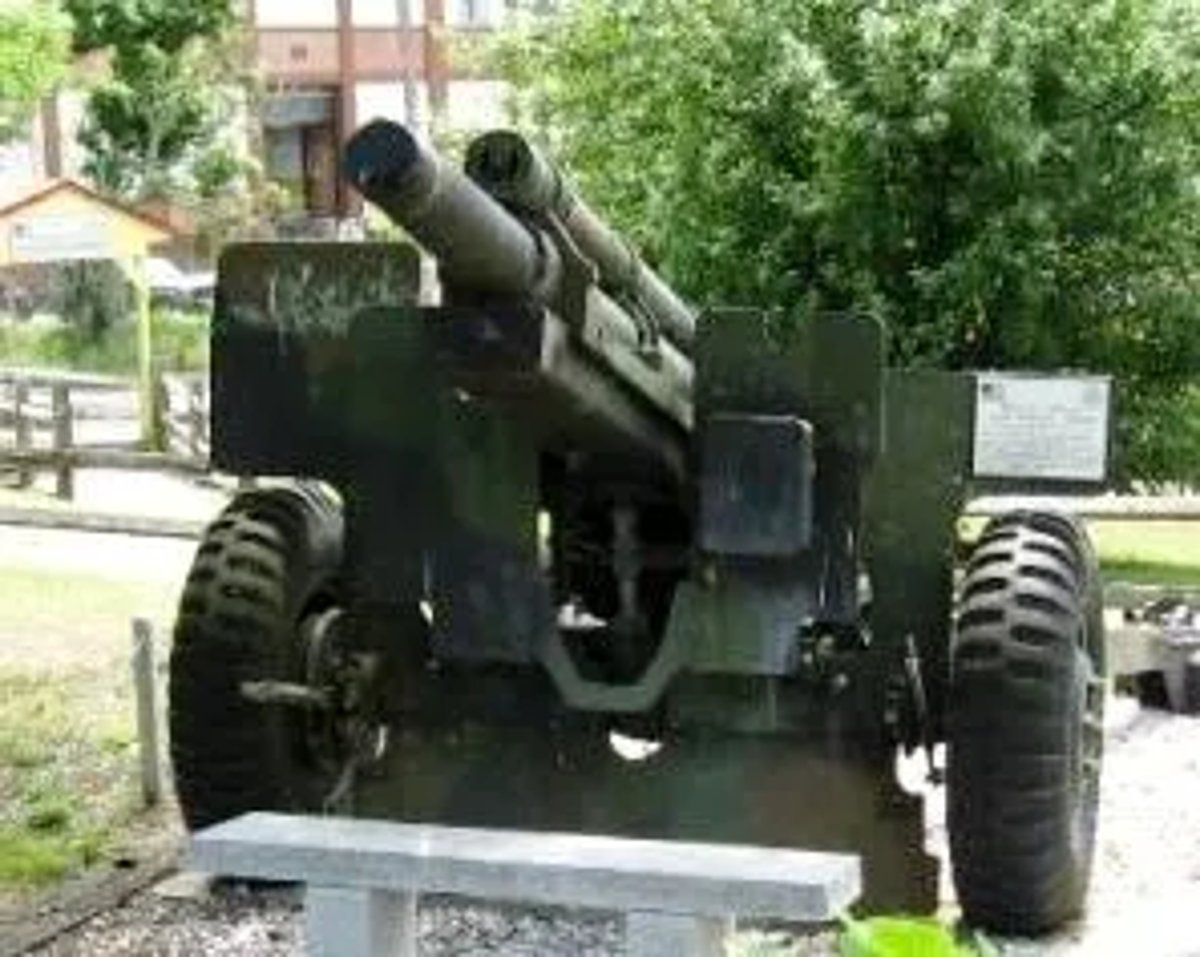
(733rd Field Battalion Photo)
57-mm M1A1 Anti-tank Gun, Waterbury War Memorial.

(Waymarking Photo)
German First World War 21-cm Morser.

(Raechel Guest Photo)
German First World War 7.7-cm FK 16 Field Gun.

(Michael Herrick Photo)
8-inch Siege and Garrison Mortar, in front of the Waterbury Soldier's Monument, located at the intersection of West Main Street and Church Street.
Westport


(Valerie Bueti Photos)


(Dave Pelland Photos)
Cast-iron smoothbore muzzle-loading 24-pounder gun mounted side by side with a 2nd gun on a concrete memorial, No. 1 of 2. Markings corroded, donated by the U.S. government.

(Faith Schachne Photo)
Cast-iron smoothbore muzzle-loading 24-pounder gun mounted side by side with a 2nd gun on a concrete memorial, No. 2 of 2. The monument was dedicated in 1901.
Several monuments on and near Westport’s Compo Beach mark the starting and ending point of the invasion of Danbury by British forces who landed there on April 25, 1777. The British brought about 2,000 troops to Westport, who planned to destroy war supplies being stored about 20 miles north in Danbury. The British spent the night in Weston before reaching Danbury on April 26, where they destroyed food, medicine and ammunition (but didn’t do a great job of destroying a cache of rum, which they drank instead). Warned of the pending arrival of local militia, the British evacuated Danbury and retreated south, engaging in battles in Ridgefield and Westport before sailing away on April 28. The British suffered more than 200 casualties in the fighting, and the Americans had 20 men killed and 40 wounded. Westport marks the battles with three monuments. At the intersection of Compo Road South and Post Road East, a boulder bears a plaque reading “Here occured the first engagement between the Continentals and the British Troops when they invaded Connecticut April-25-1777.” The plaque was dedicated in 1914 by the Connecticut Society Sons of the American Revolution.
Winchester

(Author Photo)
M3A1 Stuart Light Tank, Town Green. Similar to this one on display with the 3rd Cavalry Museum, Fort Hood, Texas.
Windsor Locks

(Dave Pelland Photo)
Civil War Gun, mounted on a concrete stand in front of the Memorial Hall.
Winsted

(Author Photo)
M110A2 8-inch Self-propelled Howitzer, (Serial No. BMY1076), VFW Post 296, 114 Colebrook River Road. (Similar to this one on display at Camp Mabry, Austin, Texas.
Wolcott

(Brian Whalen Photo)



(Rudy Lev Photos)
M4A3E8 (76) W HVSS Sherman "Easy Eight" Tank (Serial No. 61178), American Legion Post 165, 1253 Wolcott Rd.
Woodbury

(Library of Congress Photo)
32-pounder Model 1829 Gun with Blomefield pattern breeching ring, mounted on a wheeled siege carriage during the Civil War.



(Dave Pelland Photos)
32-pounder Model 1829 smoothbore muzzleloading Gun with Blomefield pattern breeching ring, No. 1 of 2 with the Soldier's Monument on the South Green.

Five-man gun crew posing with their 32-pounder Model 1829 smoothbore muzzleloading Gun mounted on a barbette during the Civil War. (Library of Congress Photo)
32-pounder Model 1829 smoothbore muzzleloading Gun with Blomefield pattern breeching ring, No. 2 of 2 with the Soldier's Monument on the South Green. The 32-pounder smoothbore M1829 gun was produced from 1829 to 1839, and was the most widely produced 32-pounder in America, cast in a number of different models and lengths. The Navy purchased at least 2,947 of these guns in ten different types. Well suited for shipboard use, the Model 1829 was often used by the Army as a seacoast gun in coastal forts. With the introduction of ironclads during the Civil War, the 32-pounder was unable to penetrate these new heavily armoured targets and had to be replaced in service.
Harbor Defense Command
Harbor Defense Command was a military organization of the United States Army Coast Artillery Corps designated in 1925 from predecessor organizations dating from circa 1895. It consisted of the forts, underwater minefields, and other coast defenses of a particular harbor or river. Harbor Defense Commands were disestablished in 1950 along with the Coast Artillery Corps.

(US Army Photo)
155-mm M1918 Gun on a Panama Mount, served by a gun crew of the 241st Coast Artillery at Sagamore Hill near Cape Cod Canal.
Harbour Defense Commands originated as Coast Artillery Districts, to control groups of forts constructed under the Endicott Plan, beginning in 1895. A 1909 reference shows that districts could include (depending on size) a Battle Command (later Fort Command), Fire Command, Mine Command, and Battery Commands. In 1913 the districts were redesignated as Coast Defense Commands, called "Coast Defenses of..." the area protected. At this time Coast Artillery Districts became regional commands, each controlling several Coast Defense Commands. Several of these commands were disarmed and disestablished between the First World War and the Second World War; some of these were rearmed in the Second World War with "Panama Mounts", circular concrete platforms for towed 155-mm guns (see photo above). In 1925 the Coast Defense Commands were redesignated as Harbor Defense Commands, called "Harbor Defenses of..." the area protected. After the Second World War all of these commands were disarmed within a few years, and they and the Coast Artillery Corps were disestablished in 1950. (Wikipedia)





